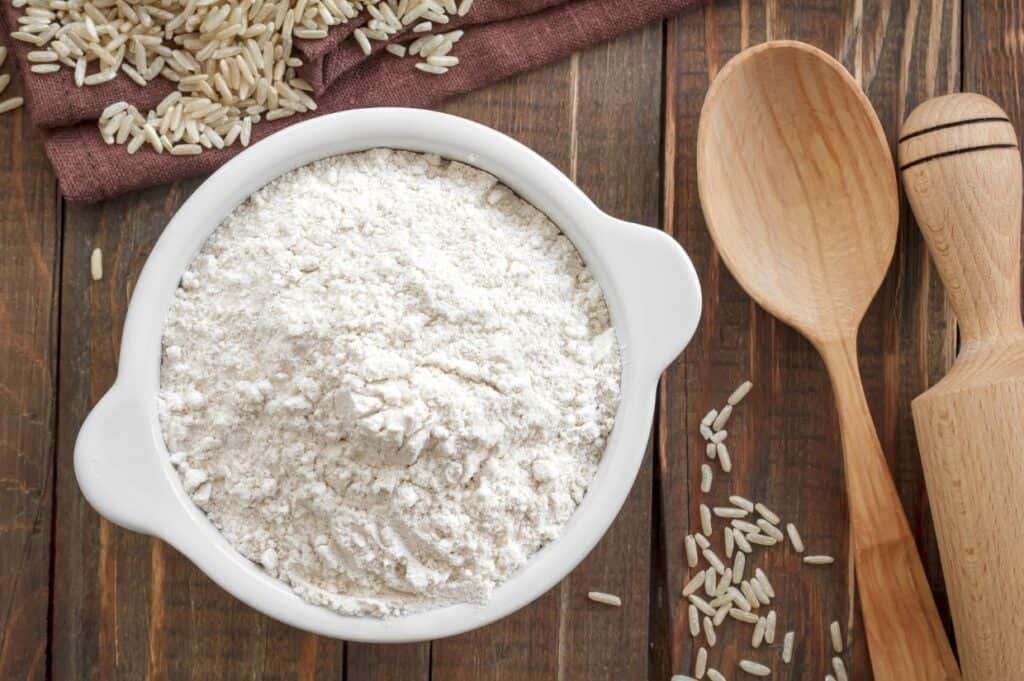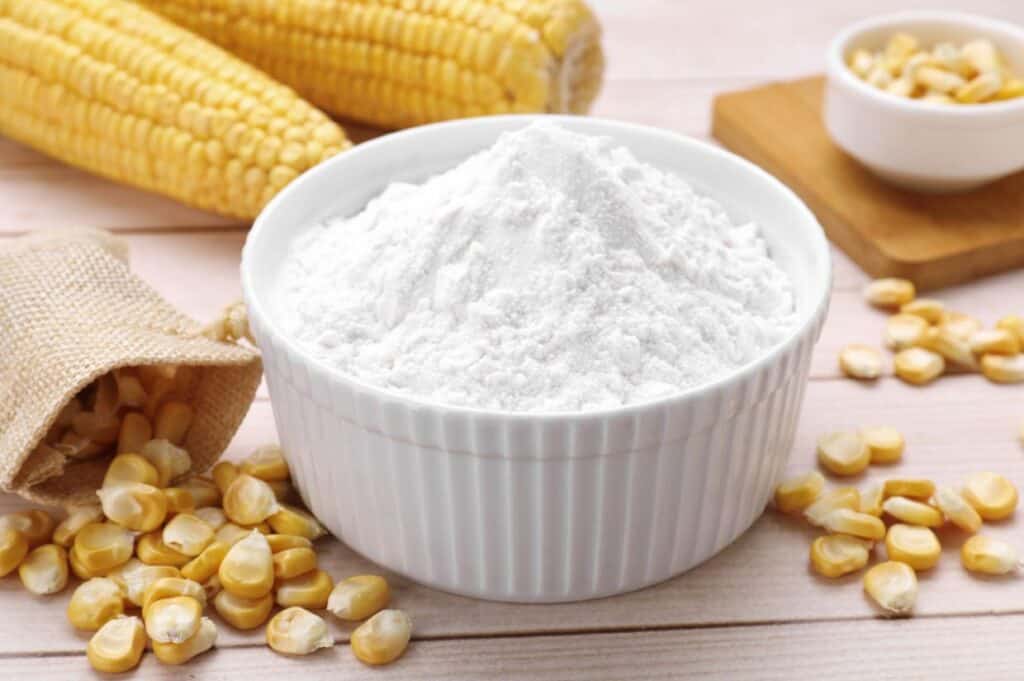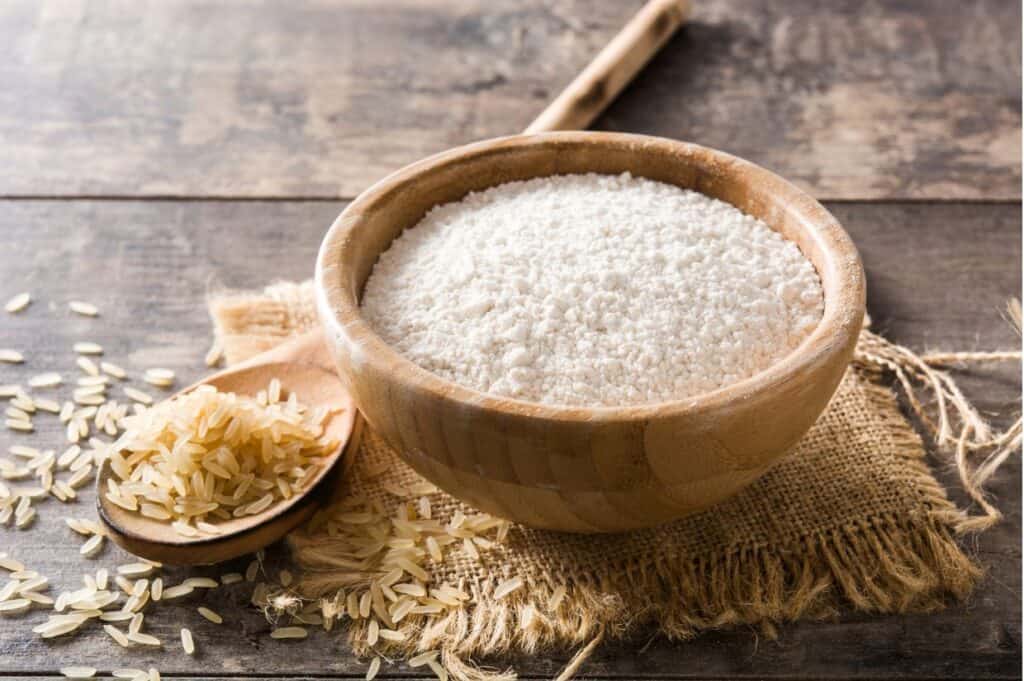If you are looking for glutinous rice flour substitutes, you will be glad to know several options are available. While not all replacements will produce the same results, they are worth exploring. Here are the top 11 alternatives to substitute for glutinous rice flour:

What is glutinous rice flour?
Glutinous rice flour is a type of flour that, as the name suggests, is made from glutinous rice. Also known as waxy rice flour or sticky rice flour, it is commonly used in Asian savory dishes, rice cakes, and desserts. It is a staple ingredient in Chinese and Southeast Asian for sweets, baked goods, and dumplings.
For example, two recipes made with glutinous rice flour are the Chinese Red Bean Cake Recipe and the Chinese Pumpkin Cake.
1. Almond flour
Almond flour is another excellent glutinous rice flour substitute. It offers a similar consistency and is suitable for making Japanese rice cakes, pancakes, dumplings and rice noodles. The primary difference between glutinous rice flour and almond flour is that almond flour doesn’t have the sticky consistency of glutinous rice flour, so it might not be suitable for recipes that require much stickiness, like mochi.
2. Arrowroot flour
Arrowroot flour is one of the best glutinous rice flour substitutes. While it doesn’t have the same consistency as waxy rice flour, it absorbs more liquid, so you must use less liquid when cooking. Another essential thing to note is that arrowroot powder has a slightly bitter flavor. This makes it suitable for recipes with other intense flavors, such as chili or curry.
3. Brown rice flour
Brown rice flour is an acceptable glutinous rice flour alternative. It is less refined than glutinous rice flour, so expect your dish to be smoother. One way to tackle this issue is to sift the brown rice flour before adding it to the recipe. It is also somewhat heavier than glutinous rice flour, so it’s unsuitable as a leavening agent. However, you can use it as a thickening agent.
4. Chapssal flour
Chapssal flour can also be used as a sweet rice flour substitute because it is a Korean variety of glutinous rice called chapassal. In Japan, it is commonly used to make sweet dumplings. Chapssal is often noted for its fine, powdery texture. When using it as a glutinous rice flour substitute in a recipe, you can add certain ingredients, like eggs, egg whites or cornstarch, which increase stickiness making it more similar in texture to glutinous rice flour.
5. Coconut flour
Coconut flour is a good substitute for glutinous rice flour and provides a subtle coconut flavor to sweet baked goods. It works particularly well in recipes that require many eggs because it quickly absorbs moisture and gives the recipe structure. However, it can be quite drying and may cause baked goods to be heavy and dense. That’s why it is recommended that you use small amounts of it when baking.
6. Cornstarch
Cornstarch is a popular ingredient to substitute for glutinous rice flour. It is readily available in most grocery stores and supermarkets. It has a neutral flavor and texture similar to glutinous rice flour. However, an important thing to remember is that it is not as sticky as glutinous rice flour and doesn’t absorb flavor. When using it as a substitute for glutinous rice flour, you must use twice as much cornstarch as glutinous rice flour.

7. Mochiko flour
Mochiko flour is one of the best substitutes for glutinous rice flour, depending on what type of food you are cooking and your desired texture. Generally, you can use mochiko flour in savory and sweet dishes, and the results will be as good as those made with glutinous rice flour. The best thing about mochiko flour is that it is readily available in Asian markets and online. You can also make it at home by combining rice flour and cornstarch in equal proportions.
8. Potato starch
Potato starch is one of the most common alternatives for glutinous rice flour and is suitable for various recipes. However, remember that it doesn’t have the same sweet taste and sticky quality as glutinous rice flour, so it might not be ideal for desserts. When using it as a substitute for glutinous rice flour, use a 1:1 ratio. Adding an extra cup of liquid is also recommended.
9. Rice flour
If you cannot find glutinous rice flour, you can use regular rice flour as a substitute. Rice flour is made from ground long- or medium-grain rice (a typical type of rice). While rice flour has a slightly different flavor, it is still a good option, mainly if the recipe requires glutinous rice flour. White rice flour has an issue with stickiness, meaning the texture will not be the same as glutinous rice flour. It is easier to find than glutinous rice flour, making it a better choice for some people.

10. Shiratamako flour
Made from glutinous rice, shiratamako flour has a slightly sweeter flavor than glutinous flour but is still a great alternate option for most recipes. It is commonly used to make sweet dumplings in Japan. It has a very smooth, fluffy, and chewy texture. Making this flour at home is also possible by grinding the rice in a coffee grinder or food processor.
11. Tapioca flour
Both glutinous rice flour and tapioca flour feature a similar starchy texture. Tapioca starch is a versatile and delicious substitute for glutinous rice flour, but it doesn’t have the same sticky texture. So, you will need to use less of it when adding it to a recipe. Also, since it is sweeter than glutinous rice flour, you must adjust the amount of sugar in the recipe.
Final thoughts
Just because you don’t have glutinous rice flour on hand doesn’t mean you cannot enjoy your favorite sweet rice flour recipes. The next time you need glutinous rice flour and have limited stock, look around and see if you have anything similar to the gluten-free flour listed above. These great substitutes may not be as fluffy, sticky, or sweet as your original glutinous rice flour, but they are the closest options.
Yuan is a U.S.-based writer, world traveler, web developer, and photographer behind the food blog Sassy Chopsticks. She loves to share a variety of flavorful, authentic Chinese food and Asian-inspired recipes for everyday cooking.
This article originally appeared on Sassy Chopsticks.